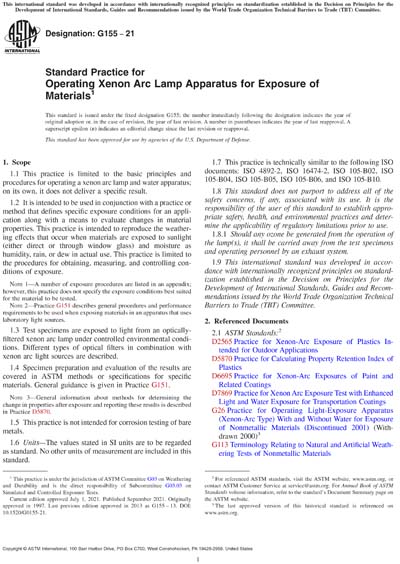Most recent
ASTM G155-21
Standard Practice for Operating Xenon Arc Lamp Apparatus for Exposure of Materials
1.1This practice is limited to the basic principles and procedures for operating a xenon arc lamp and water apparatus; on its own, it does not deliver a specific result.
1.2It is intended to be used in conjunction with a practice or method that defines specific exposure conditions for an application along with a means to evaluate changes in material properties. This practice is intended to reproduce the weathering effects that occur when materials are exposed to sunlight (either direct or through window glass) and moisture as humidity, rain, or dew in actual use. This practice is limited to the procedures for obtaining, measuring, and controlling conditions of exposure.
Note 1:A number of exposure procedures are listed in an appendix; however, this practice does not specify the exposure conditions best suited for the material to be tested.
Note 2:Practice G151 describes general procedures and performance requirements to be used when exposing materials in an apparatus that uses laboratory light sources.
1.3Test specimens are exposed to light from an optically-filtered xenon arc lamp under controlled environmental conditions. Different types of optical filters in combination with xenon arc light sources are described.
1.4Specimen preparation and evaluation of the results are covered in ASTM methods or specifications for specific materials. General guidance is given in Practice G151.
Note 3:General information about methods for determining the change in properties after exposure and reporting these results is described in Practice D5870.
1.5This practice is not intended for corrosion testing of bare metals.
1.6Units - The values stated in SI units are to be regarded as standard. No other units of measurement are included in this standard.
1.7This practice is technically similar to the following ISO documents: ISO 4892-2, ISO 16474-2, ISO 105-B02, ISO 105-B04, ISO 105-B05, ISO 105-B06, and ISO 105-B10.
1.8This standard does not purport to address all of the safety concerns, if any, associated with its use. It is the responsibility of the user of this standard to establish appropriate safety, health, and environmental practices and determine the applicability of regulatory limitations prior to use.
1.8.1Should any ozone be generated from the operation of the lamp(s), it shall be carried away from the test specimens and operating personnel by an exhaust system.
1.9This international standard was developed in accordance with internationally recognized principles on standardization established in the Decision on Principles for the Development of International Standards, Guides and Recommendations issued by the World Trade Organization Technical Barriers to Trade (TBT) Committee.
Content Provider
ASTM International [astm]






